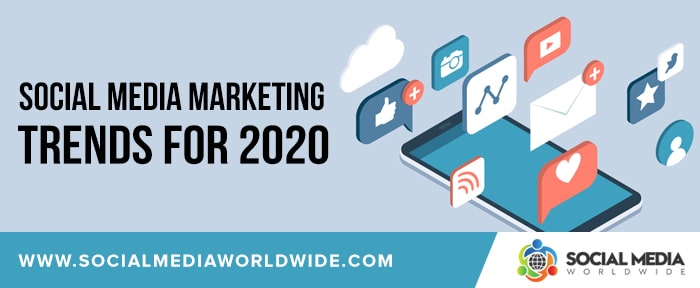If you thought that social media would start losing popularity after a series of Facebook data privacy scandals and frequent accusations that these platforms are huge productivity killers, you were wrong.
Facebook & co. are still standing strong with no sign of losing steam.
On the other hand, new technologies and tools that become available on an almost daily basis improve the way brands can utilize social media to connect with and engage their customers.
This means that you have to be an early adopter of these new trends and novelties in order to stay ahead of the curve and stand out among all your competitors.
Here’s what you should take into consideration for 2020.
The Year of the Influencer
Yes, it’s true that a similar statement has been used for a number of previous years in a row – it was said that 2017, 2018, and 2019 would be dominated by influencer marketing.
However, this trend won’t be going anywhere anytime soon. Moreover, what we’re talking about here is Influencer Marketing 2.0.
First of all, you don’t have to ask people from the Jenner-Kardashian clan to promote your brand in order to spread the word. Instead, opt for micro-influencers and nano-influencers.
The former term refers to your average, everyday people who are passionate about a certain topic and have amassed a decent following. About 50,000, to be more precise.
These aren’t household names and they’re much more affordable than Kylie and Kim. But their small-scale popularity doesn’t come at the expense of engagement – their followers are usually very loyal and willing to take their word.
Similarly, nano-influencers come with 1,000-5,000 followers. Their advantage? A very close relationship with their fans and a pretty high engagement rate.
Embrace High-Tech
Failing to use the latest tech as soon as it becomes available is one of the biggest social media mistakes.
Augmented reality (AR) and virtual reality (VR) have gone mainstream, and these two immersive technologies can significantly improve your customer experience.
Paired with social media chatbots, AR is set to disrupt the way people use social media and shop.
For example, IKEA leverages AR in order to help its customers see how a particular piece of furniture will look like in their apartments.
Sephora Virtual Artist is a pretty useful application as it removes one of the most common sources of friction from the online customer journey – lack of opportunity to try out, touch, and feel products. It allows customers to upload their selfies and try out different lipstick and eyeshadow colors and shades.
All these examples make it much easier for consumers to order items online.
Take Advantage of Ephemeral Content
Ephemeral content is another buzzword that has been around for some time. The frenzy started out with Snapchat and its expiring messages.
In order to play on the FOMO (fear of missing out) effect, the instant messenger took people’s need to be included and stay in the loop to a whole new level. You don’t read a message within a limited timeframe and poof – it’s irretrievably gone.
As for the power of FOMO, let’s just say that 60% of millennials say they made reactive purchases after experiencing this phenomenon, mainly within 24 hours.
Even though Snapchat isn’t as popular as it used to be, other social media platforms have adopted its main concept and encouraged their users to create ephemeral content.
Apart from the element of FOMO, ephemeral content – a post that’s available only for a short period of time, usually 24 hours – brings an element of exclusivity. Offering a sneak-peek into something is perfect for posting on your Instagram or Facebook story.
For example, pop singer Adele released a 30-second snippet of her then-upcoming song “Hello” during the commercial break of the X Factor UK edition and left the entire audience wondering what they had just heard.
The Power of Social Listening
The Cambridge Analytica Scandal proved that social media platforms are gold mines of customer information.
In the years to come, social listening will be a growing trend among brands. Instead of taking a stab in the dark, more and more companies will start using social listening tools in order to identify what customers are saying about them on social media and spot a potential crisis.
The latest social listening tools are powered by artificial intelligence and machine learning and are capable of pinpointing customers’ sentiments and perceptions of a brand.
Besides that, this strategy can be used for a number of different purposes such as:
- Lead generation. By finding people who are interested in your brand on social media and targeting them with your ads and content, you can get them to convert.
- Preventing content theft. Social listening tools can notify you if someone has stolen your content so that you can do something about it.
- Product development. If you aren’t exactly sure how to identify a gap in the market and what kind of product and features people would like to actually purchase and use, try social listening. By exploring what people are talking about on social media, you’ll most certainly get inspiration.
These social marketing trends might not be brand new, but they’re effective and together with new technologies will be reaching their prime in 2020. Make sure to implement them in your social media strategy.
About the Author
Michael has been working in marketing for almost a decade and has worked with a huge range of clients, which has made him knowledgeable on many different subjects. He has recently rediscovered a passion for writing and hopes to make it a daily habit. You can read more of Michael’s work at Qeedle.




Great Article. Its really informative and innovative. keep posting with latest updates. Thanks for sharing.
Its really hard to find such an amazing content nowadays, it feels really good after reading your post.
Hey, Thank you for sharing the article. The strategies you have mentioned are more practical.